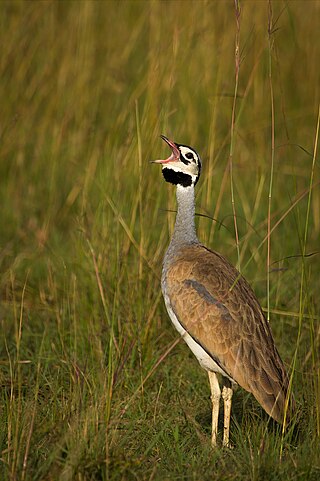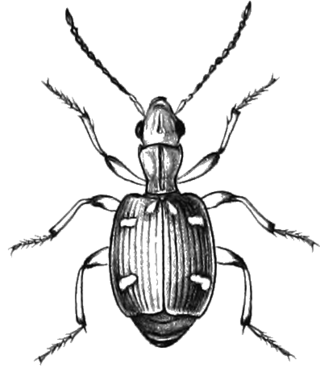
The Senegal bushbaby, also known as the Senegal galago, the lesser galago or the lesser bush baby, is a small, nocturnal primate, a member of the galago family Galagidae.

Lesser bushbabies, or lesser galagos, are strepsirrhine primates of the genus Galago. They are classified, along with the bushbabies and the rest of the galagos, in the family Galagidae. They are probably the most numerous primate in Africa, and can be found in every large forest on the continent, inhabiting forested areas, savannas, riverine bush and open woodlands.

The mosque swallow is a large swallow. It is a resident breeder in much of sub-Saharan Africa, although most common in the west. It does not migrate but follows the rains to some extent.

The woodland kingfisher is a tree kingfisher that is widely distributed in Africa south of the Sahara.

The laughing dove is a small pigeon that is a resident breeder in Africa, the Middle East, South Asia, and Western Australia where it has established itself in the wild after being released from Perth Zoo in 1898. This small long-tailed dove is found in dry scrub and semi-desert habitats where pairs can often be seen feeding on the ground. It is closely related to the spotted dove which is distinguished by a white and black chequered necklace. Other names include laughing turtle dove, palm dove and Senegal dove while in Asia the name of the little brown dove is often used.

The saddle-billed stork or saddlebill is a large wading bird in the stork family, Ciconiidae. It is a widespread species which is a resident breeder in sub-Saharan Africa from Sudan, Ethiopia and Kenya south to South Africa, and in The Gambia, Senegal, Côte d'Ivoire and Chad in west Africa. It is considered endangered in South Africa.

Khaya is a genus of five tree species in the mahogany family Meliaceae. The timber of Khaya is called African mahogany, and is valued as a substitute to American mahogany.

The African scops owl is a small owl which is widespread in sub-Saharan Africa.

The mastoid lymph nodes are a small group of lymph nodes, usually two in number, located just beneath the ear, on the mastoid insertion of the sternocleidomastoideus muscle, beneath the posterior auricular muscle.

The Senegal flapshell turtle is a species of turtle in the subfamily Cyclanorbinae of the family Trionychidae. The species, which is one of two species of softshell turtles in the genus Cyclanorbis, is endemic to Africa.

The white-bellied bustard or white-bellied korhaan is an African species of bustard. It is widespread in sub-Saharan Africa in grassland and open woodland habitats.

The scarlet-chested sunbird is a species of bird in the family Nectariniidae.

Annona senegalensis, commonly known as African custard-apple, wild custard apple, wild soursop, abo ibobo, sunkungo, and dorgot is a species of flowering plant in the custard apple family, Annonaceae. The specific epithet, senegalensis, translates to mean "of Senegal", the country where the type specimen was collected.

Mastax is a genus of beetles in the family Carabidae, containing the following 52 species:
Avitomyrmex is an extinct genus of bulldog ants in the subfamily Myrmeciinae which contains three described species. The genus was described in 2006 from Ypresian stage deposits of British Columbia, Canada. Almost all the specimens collected are queens, with an exception of a single fossilised worker. These ants are large, and the eyes are also large and well developed; a sting is present in one species. The behaviour of these ants may have been similar to extant Myrmeciinae ants, such as foraging solitarily for arthropod prey and never leaving pheromone trails to food sources. Avitomyrmex has not been assigned to any tribe, instead generally being regarded as incertae sedis within Myrmeciinae. However, its identity as an ant has been challenged, although it is undoubtedly a hymenopteran insect.
Mastax formosana is a species of beetle in the family Carabidae with a restricted distribution in Taiwan.
Mastax congoensis is a species of beetle in the family Carabidae with restricted distribution in the Afghanistan.
Mastax liebkei is a species of beetle in the family Carabidae with restricted distribution in the Democratic Republic of Congo.
Mastax pakistana is a species of beetle in the family Carabidae with restricted distribution in the Pakistan.
Mastax rawalpindi is a species of beetle in the family Carabidae with restricted distribution in the Pakistan.













